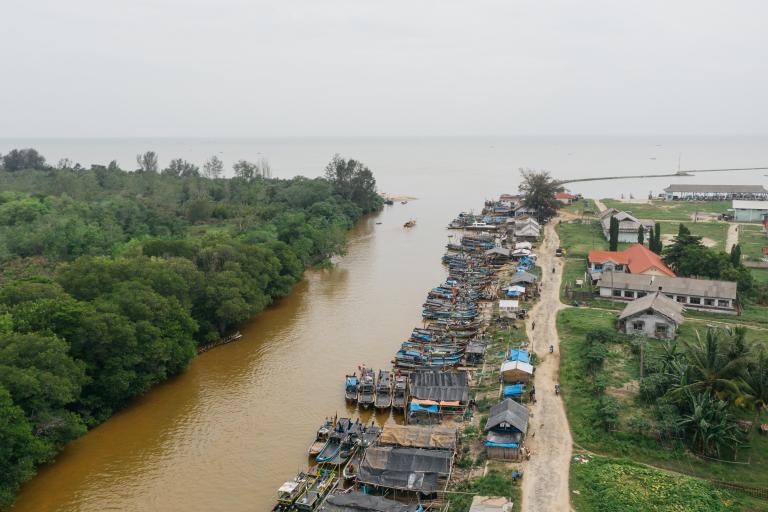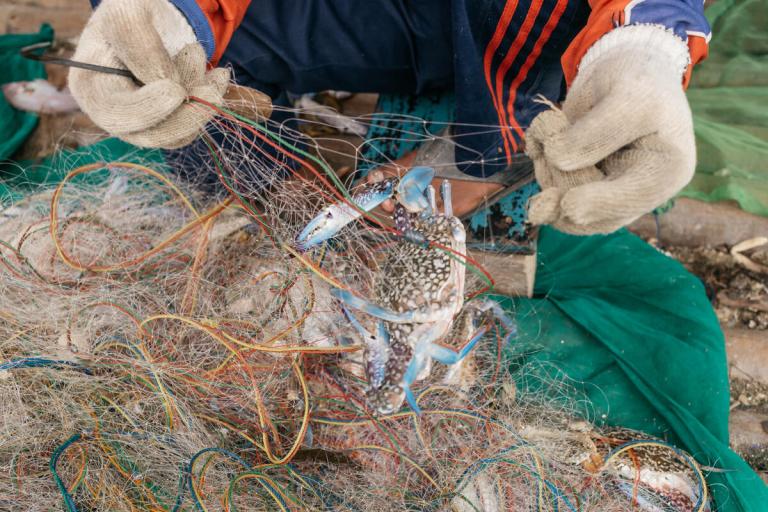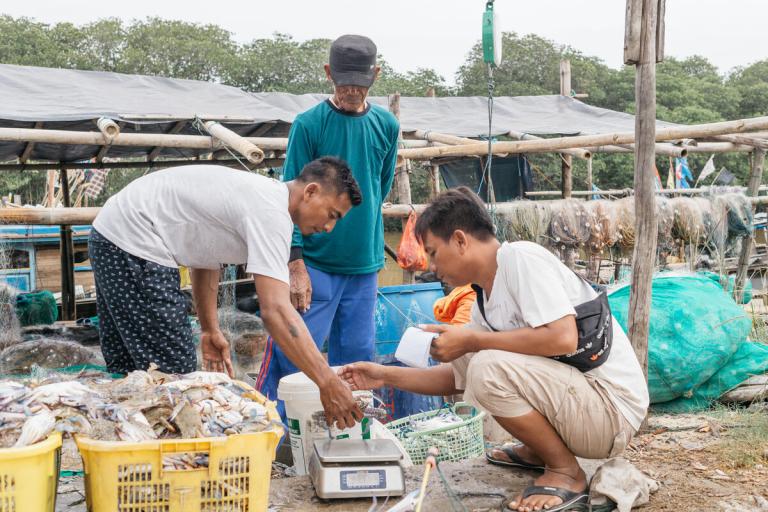

Adaptive Management Plan in Lampung Province, Indonesia
Learn how a fisheries technical manager used FISHE for a Blue Swimming Crab fishery
Adityo Setiawan, a fisheries technical manager, utilized the Framework for Integrated Stock and Habitat Evaluation (FISHE) Tool to develop an adaptive management plan for the Blue Swimming Crab fishery in Lampung Province, Indonesia. A large group of stakeholders – government officials, fishers, processors, NGOs, and academics – used FISHE as a step-by-step framework to work through the complex process of establishing the management plan.

FISHE provides the step by step, clear guidance so that we won’t get lost through the process. It can be applied in very data-limited fisheries and can involve all stakeholders in the process.
Adityo Setiawan: “I am a Fisheries Technical Manager for EDF in Indonesia. I’m based in Jakarta and have been working on fisheries projects with EDF for the past four years. My work involves implementation of fishery projects, organizing data collection, data analysis, and stakeholder engagement. In the Blue Swimming Crab (BSC) fishery in Lampung Province, I have been working on the implementation phase of the FISHE Tool.”
FISHE in Action
Expand AllAdit: “The BSC fishery in Lampung Province, Indonesia is small-scale. Fishers use small, colorful, wooden fishing boats to catch the crabs in gillnets and traps. Their fishing trips range from half day to three to four-day trips. The fishers mostly target BSC, however, when it’s low season or when the price is low, they change their gear and target other species.
The fishery took off in the 1990s when there was a rise in demand globally and people began harvesting more BSC in Lampung for export. Now the fishery is a big industry in the province and there are indications of overexploitation, like decreasing size and quality.
We work with around 4,000 fishers, focused on three districts along the eastern coast of Lampung. We also work with the middlemen buyers, small processing plants, and five large plants in Lampung, which all combined employ a couple thousand workers.”


Adit: “There are different institutions working at different steps of the fishery from capture to processing. You have limited infrastructure, limited budgets, and need to coordinate across a wide array of stakeholders and agencies. So we began using FISHE in Lampung to bring all these stakeholders together and develop a comprehensive management plan for the Blue Swimming Crab. The FISHE Tool gave us a framework to have a participatory, cross-sector process involving universities, government, local stakeholders, fishers, etc.
We worked through the FISHE process step by step, with each meeting achieving a step in the process. At a high level through the FISHE process we – established the local management planning team; characterized the fishery to understand its status; utilized the Comprehensive Assessment of Risk to Ecosystems (CARE) Tool; conducted a Productivity and Susceptibility Analysis (PSA); developed the goals and objectives for the fishery; selected the performance indicators, reference points, and response rules; developed a data collection plan.
With FISHE we worked with the stakeholders to think through what is the goal?; what performance indicators will we use to measure that goal?; and how can we collect data to assess progress on the performance indicators? FISHE provided options for these things, so we could work with the group to select the best options for the fishery as we worked through the process.”
Framework for Integrated Stock and Habitat Evaluation (FISHE) is an eleven-step process for providing scientific guidance for the management of data-limited fisheries. There are individual tools at each step that can help run analyses for things such as stock assessments or prioritizations. In the case of the Blue Swimming Crab fishery in Lampung, EDF and partners utilized the entire FISHE process.
Adit: “The adaptive management plan was completed in 2018, after which we began data collection. A science committee was established to analyze the data and provide recommendations. FISHE provides options on what data to collect and how to analyze it to know if you’re achieving the chosen indicators. The scientists used recommendations provided in FISHE, such as LBSPR and catch trends, to analyze the data. This information is now being used to adapt the management plan and implement new strategies.
Before the FISHE process, all the stakeholders were working on their own things and not talking to each other. But during the FISHE management initiative the stakeholders came together, they identified the issues and then they tried to figure out how to solve the issues. It got everyone talking to each other in order to develop strategies to better manage the Blue Swimming Crab in Lampung. There was also lots of capacity building as part of the FISHE process, which helped all the stakeholders become aware of the importance of this fishery and maintaining the crab stock.”

Adit: “We are now working through the same FISHE process in West Java for their BSC fishery. We’re working with the stakeholders to develop the goals and choose the indicators and target reference points. We’ve been able to take a lot of the lessons learned from FISHE in Lampung Province and apply them to this new process in West Java. As fishers and government officers in other parts of Indonesia hear about this process there have been requests for this same process to happen in other fisheries and regions.”

FISHE provides a step-by-step framework to develop a fisheries management plan, with explanations and clear guidance for each step.
Advice from the User
Adit: “Many people think that the first step of fisheries management is collecting stock data. With FISHE you actually start with what you already have, incorporating the knowledge of the local stakeholders, especially fishermen, since they’re the ones who experience any changes in the waters. Since FISHE is adaptive, you can bring in qualitative information to start and make assessments based on that. Then you can adapt later on, but you don’t need to start with quantitative stock data.
It’s good to make sure you learn about and understand the whole FISHE process before beginning the step-by-step process.
FISHE is a long process so it’s important to have a very good facilitator who can keep the stakeholders engaged. The FISHE process makes our work easier as a facilitator because in each step there’s already guidance developed. I generally recommend that you have good support in terms of resources and facilitators to help keep things moving along.”


